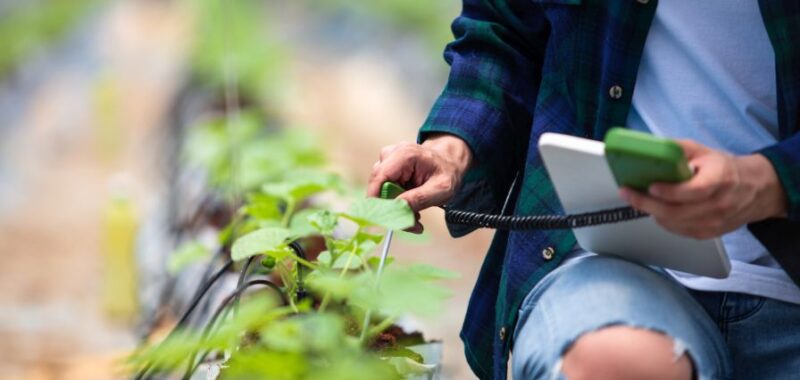
A greenhouse worker using a tablet to control agricultural system on herb crops. | Toa55 via Adobe Stock
The demand for culinary herbs is growing rapidly in the U.S., increasing by up to 10% annually. However, field production is concentrated in California, Hawaii, and Florida, leaving herb availability vulnerable to climate and supply chain challenges. In addition, the nation imports more than $294 million in fresh herbs each year.
However, growing herbs in controlled environments, such as greenhouses and indoor farms, could expand production nationwide, reduce reliance on imports, stabilize the supply, and create local jobs, according to Dr. Roberto Lopez of Michigan State University, Project Director of the CEA Herb Extension and Research team.
“There’s a lot of interest in moving food production closer to population centers,” says NIFA National Program Leader Dr. Tom Bewick. “By developing controlled environment systems, it’s possible to grow fresh produce year-round closer to where it will be consumed. That’s a win for both producers and consumers. What we learn by growing culinary herbs in controlled environments can be adapted to work for other crops.”
Lopez and his collaborators from Michigan State University, Iowa State University, University of Tennessee, Texas Tech, North Carolina State University, and USDA’s Agricultural Research Service are developing a set of growing, post-harvest, marketing, and food safety best practices for culinary herb production in controlled environments to improve the availability and safety of locally grown fresh-cut and potted herbs. “By taking seasonal variability largely out of the equation, year-round, local production is a reality,” he says.
Funded by USDA’s National Institute of Food and Agriculture through the Specialty Crop Research Initiative, the project focuses on improving yield, enhancing flavor and aroma, and preventing issues like chilling injuries, diseases, and nutritional imbalances while increasing the shelf-life of herbs.
So far, the team has determined several factors impacting culinary herb production and quality: Seed sowing density, the color of light (ultraviolet, blue, and far-red), water pH, and water temperature in hydroponic systems greatly influence yield and growth, impacting stem length, leaf size, and foliage color. They also have found that living containerized herbs have similar post-harvest performance across conventional or organic water-soluble or controlled-release fertilizers.
“We have identified a range of root rots and leaf blights affecting herbs, many that have not been previously described,” says Lopez. “Additionally, we have discovered that if a foodborne bacterium such as Salmonella or Escherichia coli is introduced into a hydroponic system growing fresh-cut herbs, the bacteria can survive, colonize and multiply throughout the system.”
This discovery highlights the importance of proper food safety measures, prompting investigators to develop a food safety employee training program and a strategic plan to ensure herb product safety. They also are creating guides to assist growers in identifying and properly resolving nutritional disorders.
“By developing food safety guides for herb producers, we aim to strengthen food safety culture and prevent outbreaks that can lead to illnesses and death,” Lopez says.
Since quality is a primary driver of both fresh-cut and containerized culinary herb plants, the researchers believe growers can increase sales by implementing production practices that improve quality, extend shelf-life, enhance food safety, and reduce insect and disease pressure while aligning marketing efforts with customer needs.
“National surveys have identified that U.S. consumers value herbs grown using organic and sustainable production practices over those grown conventionally or locally,” says Lopez. “Furthermore, we’ve seen that domestically grown herbs generate premiums over imported herbs.”
Mischelle Gielow, Young Plants Head Grower with Wenke Greenhouses in Kalamazoo, MI, says downy mildew and fertigation (delivering nutrients to crops through an irrigation system) information provided by the researchers has helped the greenhouse improve disease control.
“Recommendations for separating calcium-loving plants from neutral plants has helped us optimize growth better,” says Gielow. “Spray technique recommendations for downy mildew on basil have helped us reduce the incidence of disease in the crop. Recommendations on number of seeds per pot is helpful for turning crops through the greenhouse faster.”
For additional information on efforts to boost local herb production in controlled environments, please read the full article on the National Institute of Food and Agriculture division of the USDA website.

